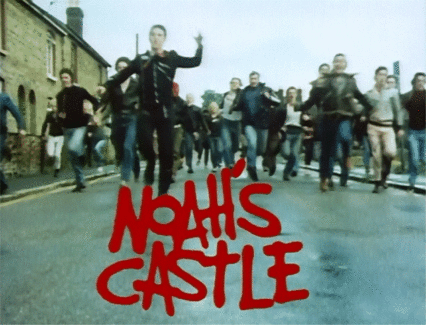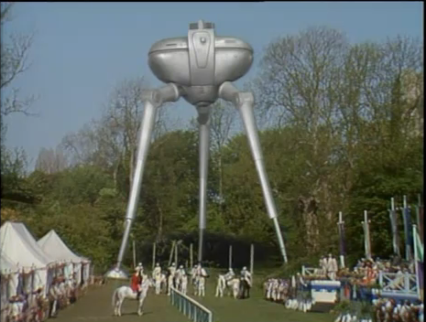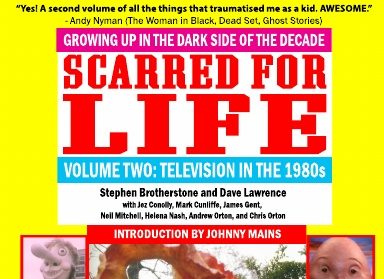Remember what television was like in the ’80s? Here, David Cottis reviews Scarred for Life Volume Two, Dave Lawrence and Stephen Brotherstone‘s follow up to their deep dive into 1970s pop culture, covering a decade of everything from public information films to horror and sci-fi shows.
If you’re a student of British television, the 29th of December 1981 is a date with an almost totemic significance. That evening, in the no-man’s-land between the indigestion of Christmas and the hangover of New Year, BBC1 showed Artemis 81, a three-hour poetic, beautiful and (let it be said) frequently incomprehensible play by the visionary writer David Rudkin (Penda’s Fen). Over on ITV, for viewers who found this a little challenging, there was the Royal Shakespeare Company production of Chekhov’s Three Sisters, with a cracking cast, directed by Trevor Nunn. BBC2, the minority channel, was showing Billy Wilder’s The Apartment, oddly enough probably the only programme of that evening that would be shown today, at least on a mainstream channel.
 As you might expect, this was an evening that polarised its audience; Time Out advised its readers (in a recommendation that carries its own historical timecode) to ‘rent a video recorder’ so they could watch both programmes, while a correspondent in the Daily Mail asked if the programmers were ‘trying to bore us to death’. As Dave Lawrence, one of the two main writers on this baggy, treasure-filled guide, writes ‘[t]here was no escape from high-art and ruthless introspection that Christmas, and perhaps that’s how it should be’.
As you might expect, this was an evening that polarised its audience; Time Out advised its readers (in a recommendation that carries its own historical timecode) to ‘rent a video recorder’ so they could watch both programmes, while a correspondent in the Daily Mail asked if the programmers were ‘trying to bore us to death’. As Dave Lawrence, one of the two main writers on this baggy, treasure-filled guide, writes ‘[t]here was no escape from high-art and ruthless introspection that Christmas, and perhaps that’s how it should be’.
Scarred for Life Volume Two is a follow-up to the authors’ previous volume about pop culture of the 1970s, specifically what they call ‘the dark side of the decade’, those items that writers of a certain age remember watching when they were a bit too young, and being traumatised by – The Owl Service, Children of the Stones, that Public Information Film with Donald Pleasence as the Spirit of Water… The present volume is one of two that will do the same job for the ’eighties, and focusses exclusively on television – fans of Clive Barker, Halo Jones and When the Wind Blows will have to wait for Volume Three.
Where much of the first volume dealt with material that still bore the influence of the hippie era (including the aforementioned Penda’s Fen), the tone of this volume is harder-edged, coming out of the anxieties of the Thatcher/Reagan years. The keynote is set by the very first essay, on the dystopian children’s series Noah’s Castle, set in a post-apocalyptic world of militias and survivalists who probably would have thought of Thatcher as a bit of a softie. Nuclear war is a constant theme; literally in series like Threads and Edge of Darkness, metaphorically in science-fiction shows like Tripods. Even in The Moomins, the cry of its villain, the Groke, sends everybody into a panic ‘a bit like a four-minute warning’.

Dave Lawrence and Stephen Brotherstone preface Scarred for Life Volume Two with two epigraphs. One, from Clean-Up TV Campaigner Mary Whitehouse, talks of the responsibility that goes with making television programmes, saying that the medium ‘may not always teach the truth, but teach it does’; the other is the recurring cry of TISWAS’s Chris Tarrant, as the show descended into anarchy every Saturday morning ‘THIS IS WHAT THEY WANT!’. In doing this, they position the makers of these programmes as rebels, defying establishment disapproval to give audiences the things they truly desired. This is neat, but disingenuous. Many of the shows celebrated in this book, whether made at a self-confident, imperial BBC, or by the fiercely competitive ITV regional companies, were the work of writers and directors with a strong sense of public service, and a belief that, at least some of the time, their job was to give the audiences exactly what they didn’t want, or didn’t yet know they wanted. The authors acknowledge the way that this changed throughout the decade; the 1989 adaptation of The Woman in Black, scripted by TV veteran Nigel Kneale, is referred to as ‘one of the last examples of that era’s slow-burn TV’. A multi-channel future, with a fragmented and fickle audience, was on the horizon.
In this respect, Channel Four, which nailed its colours to the mast on the 2nd of November 1982, with an opening day of Countdown, Brookside, the first Film on Four (Stephen Frears’ Walter, starring Ian McKellen), alternative comedy, and feminist cabaret, was both a throwback to earlier times, and a sign of what was to come. Jeremy Isaacs, the new Channel’s Executive Director, is described as viewing it ‘as a chocolate box; viewers were encouraged to dip in and out, enjoying the treats and, hopefully, having a nibble or two of some of the more unfamiliar delights’.
Leaving aside the questionable hygiene of that image, the authors have here almost described their own book. You may skip a few chapters – personally, I could have lived without yet another account of the decline of Dr. Who – but if you’re anywhere near the target demographic, there’s enough here, despite some repetition and clumsy writing, to make this a box of delights, with recommendations for DVDs and YouTube clips that will surely see you through this lockdown, and the next few to come.
Scarred for Life Volume Two: Television in the 1980s by Dave Lawrence and Stephen Brotherstone (as well as Volume One, if you missed it) is available exclusively from lulu.











